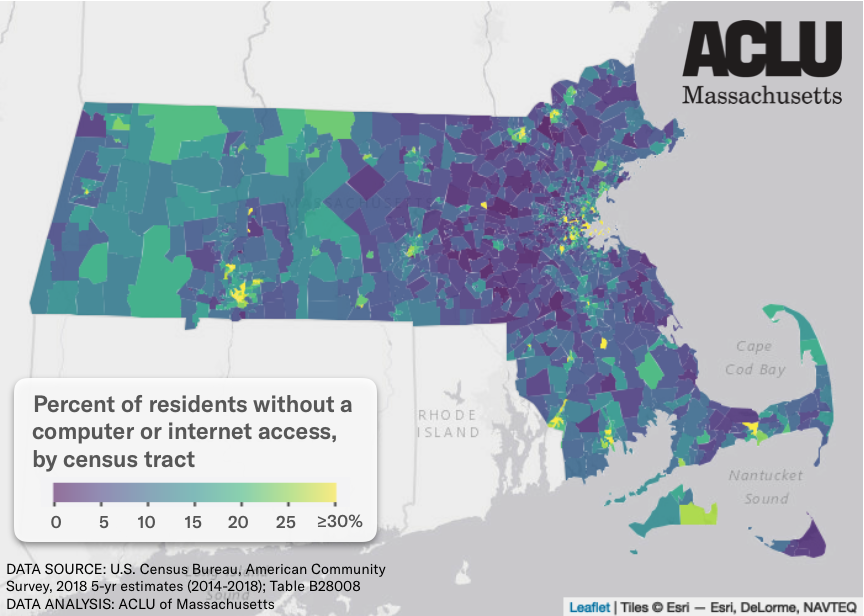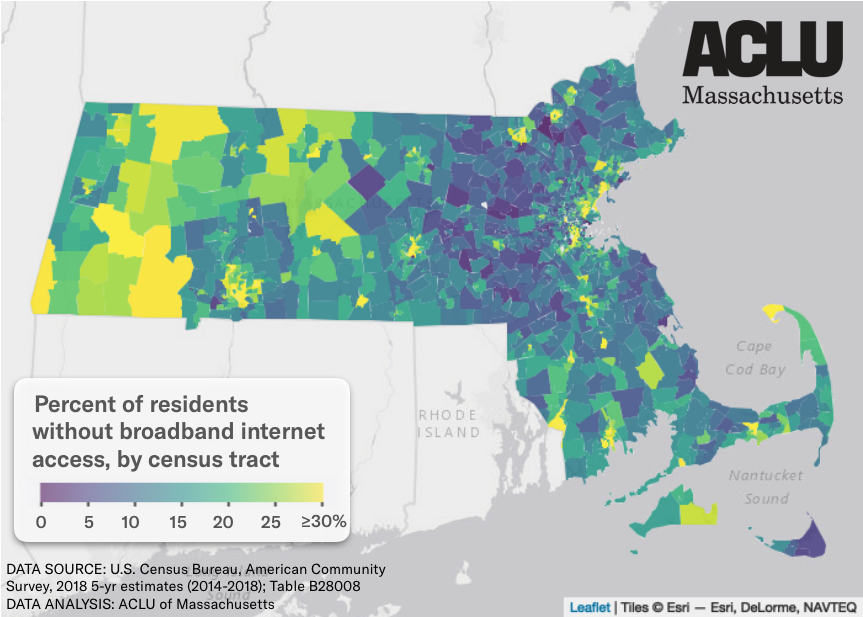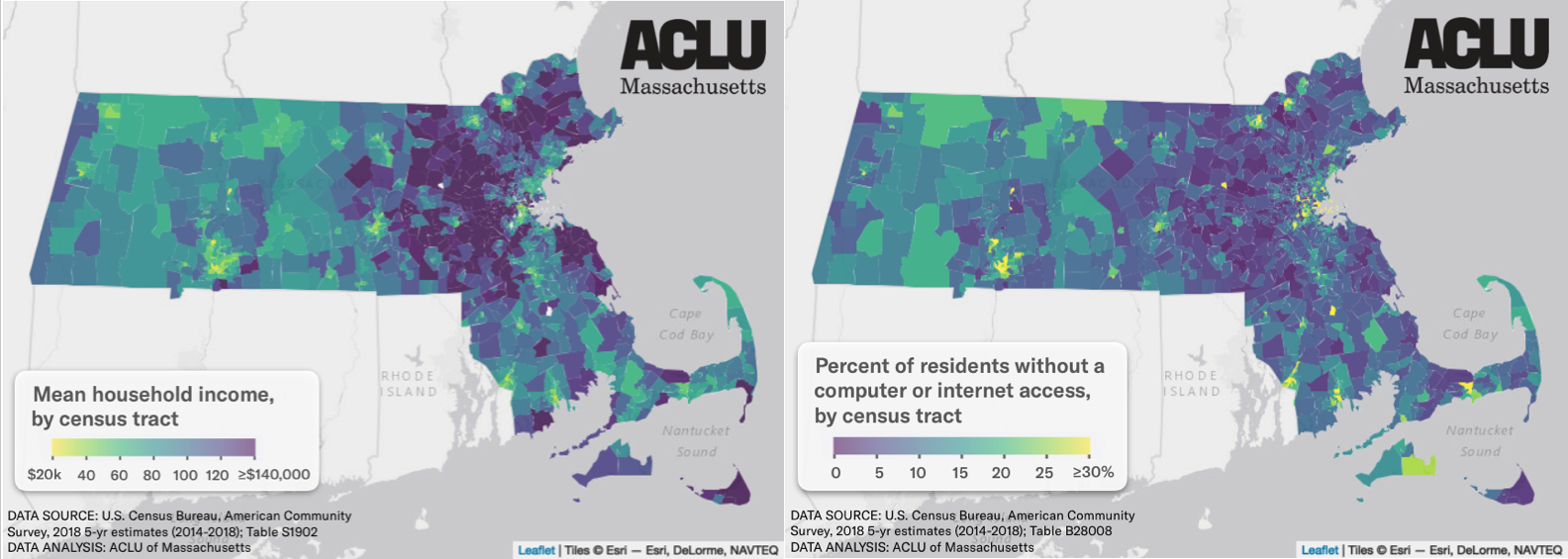Across the country, closures due to COVID-19 are forcing families and schools to take extreme measures just to get students to class, because they lack one essential resource: internet access.
From Michigan to Alabama, Pennsylvania to Oregon, school buses are being transformed into roving wi-fi hotspots. Some rural students have no choice but to drive miles to sit in parking lots of fast food restaurants and churches in order to access the internet. In Fort Worth, Texas, a school district bought three transmission towers for $600,000.
Here in Massachusetts, school districts reports show that while wealthy regions like Andover report online student participation around 95 percent, lower income areas like Chelsea are seeing attendance as low as 30 percent.
Many school districts such as Springfield and Chicopee have distributed technology, like laptops and tablets, to students. However, a laptop without internet is just as useful for modern schoolwork as a car without gas is for driving. Without the final piece of the puzzle, it’s just a glorified hunk of metal.
Using data from the Census’ American Community Survey, the ACLU of Massachusetts presents analysis of internet and computer access across the Commonwealth. We show that many urban and rural areas in Massachusetts are “internet deserts”, where access is severely limited.
Learn More: Visit our interactive site which allows detailed exploration of internet access and related social factors across Massachusetts.
Hotspots without computer or internet access
According to estimates from 2014-2018 census data, over 500,000 Massachusetts residents either do not have a computer or, while having a computer, do not have access to the internet. Statewide, this represents 8 percent of all Massachusetts residents. However, in certain regions in the Commonwealth – so-called internet deserts – over 25 percent of residents, 1 in 4, do not have a computer or internet access.

Massachusetts’ urban areas, including Boston, Lowell, Lawrence, Worcester, Springfield, and Northampton, all have neighborhoods in which over 30 percent of residents live without wi-fi. But rural areas are affected as well: northwestern and southwestern Massachusetts also have large regions where almost 20 percent (1 in 5) of folks don’t have access.
Even more without broadband internet
However, not all internet is created equal. High-speed broadband internet connections, rather than slower dial-up, are necessary for effective use of video conferencing software. Without broadband, remote students may have extra technical difficulties which prevent their participation in school.
Census estimates show that more than 1 million Massachusetts residents, over 15 percent, do not have a fixed broadband internet connection.

Again, localized areas see much higher rates: all major Massachusetts cities and large swaths of rural Western Massachusetts contain regions where over 30 percent of residents have no reliable broadband wi-fi.
Low-income areas are the most disconnected
Of course, unequal access arises from the fact that internet subscriptions cost money. Census analysis shows that internet and computer access correlate with income, such that areas with higher income communities enjoy more widespread access, while lower income neighborhoods are disproportionately left unconnected.

In the extreme era of COVID-19, it’s important to note that this analysis uses income estimates from up to only 2018. The global economic downturn and widespread job losses caused by the pandemic mean that many households are now earning much less than they did in 2018, and thus presumably even more households are going without wi-fi.
Tens of thousands of students offline
Further analysis breaking down estimates of internet access by age reveals that over 60,000 people under the age of 18 in Massachusetts, around 4 percent of all minors, have no computer or internet access at home.
Indeed, in multiple school districts across the state more than 20 percent of minors have no access to wi-fi, including those already shown to be located within internet deserts: Springfield, Lowell, Lawrence, and Petersham School Districts (Worcester).
What about your town?
Use this interactive map to explore internet access and income across Massachusetts:
As the ACLU of Massachusetts emphasized in a recent letter to the Commonwealth’s Department of Elementary and Secondary Education (DESE): unequal education isn’t just unacceptable; it’s unlawful.
DESE must take action to increase resources in low income school districts. Some individual districts, including Amherst, Chicopee, and Holyoke have set examples by providing mobile hotspots to families and securing deals with internet providers to get students free access. Now the state, too, must step up to ensure all students have access to not only computers and tablets but all of the following as well:
- Functional microphones and webcams
- Broadband internet supportive of remote video meetings
- Hardware and infrastructure required for an internet connection (e.g. cable line, modem, & router)
- Communications platforms free of charge
- Assistive technology including but not limited to screen readers, live closed captioning, and speech-to-text software for students with disabilities
- Software and websites compliant with the Web Content Accessibility Guidelines (WCAG)
- Privacy assurances for all software and devices
- Instructions written in plain English and appropriate non-English languages, such that students’ families understand and can support remote learning efforts
The Massachusetts Constitution requires that the Commonwealth provide adequate education to all students. And while remote learning is certainly a necessary measure in promoting public health, the current state of affairs means far too many Massachusetts students are now home without even the basic infrastructure for academic participation.
